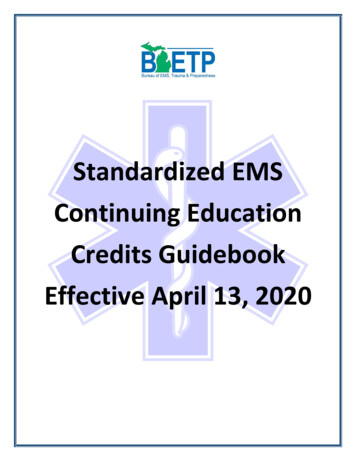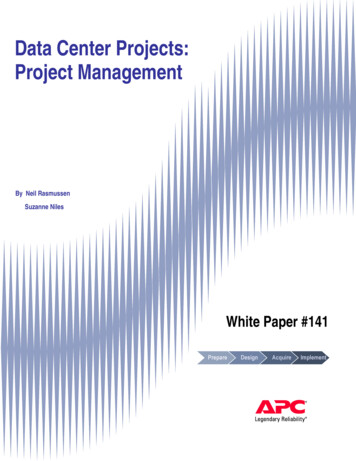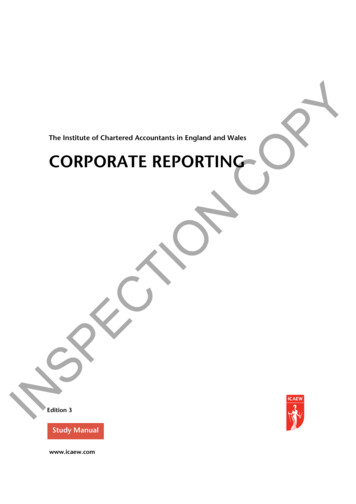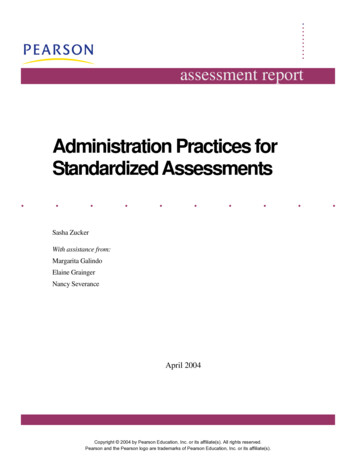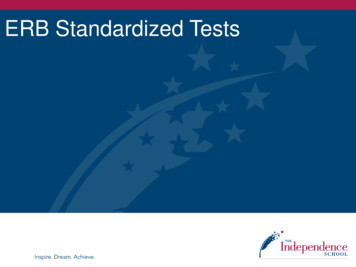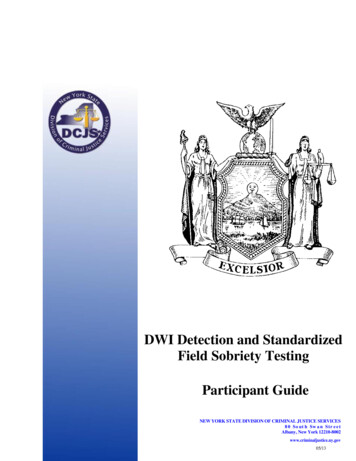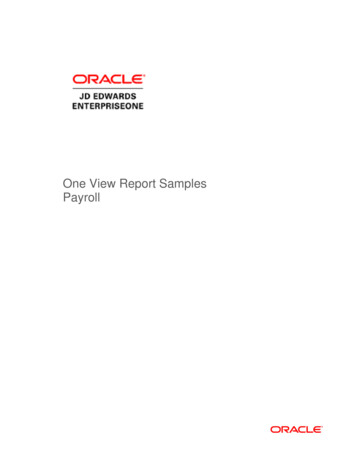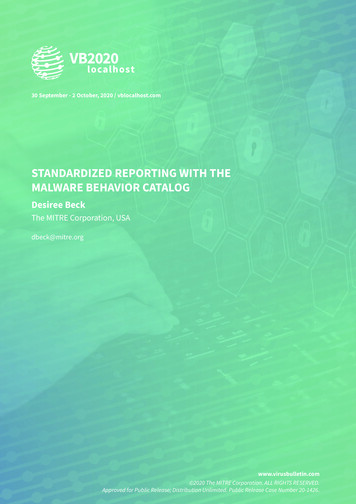
Transcription
30 September - 2 October, 2020 / vblocalhost.comSTANDARDIZED REPORTING WITH THEMALWARE BEHAVIOR CATALOGDesiree BeckThe MITRE Corporation, USAdbeck@mitre.orgwww.virusbulletin.com 2020 The MITRE Corporation. ALL RIGHTS RESERVED.Approved for Public Release; Distribution Unlimited. Public Release Case Number 20-1426.
STANDARDIZED REPORTING WITH THE MALWARE BEHAVIOR CATALOG BECKABSTRACTThe Malware Behavior Catalog (MBC) is a publicly available catalog of malware objectives and behaviors, developed tosupport malware analysis-oriented use cases, such as labeling, similarity analysis, and standardized reporting. MBC contentis available on GitHub [1].INTRODUCTIONWhile there is no formal relationship between MBC and the MITRE ATT&CK knowledgebase1, adversary behaviors andmalware behaviors overlap because adversaries often use malware as a means of carrying out their attacks. Consequently,ATT&CK is used in reporting to capture malware behaviors. For example, several commercially available sandboxes mapbehaviors to ATT&CK techniques.Many malware behaviors can be mapped directly into ATT&CK. For example, the behavior ‘starts cmd.exe for commandsexecution’ maps to ATT&CK’s ‘Command-Line Interface’ technique. However, ATT&CK is oriented toward adversaries,not malware, and it focuses on behaviors identified during an intrusion, rather than those discovered during analyses, as isdone for malware. As a result, some behaviors unique to malware cannot be mapped to ATT&CK. The need to define thesebehaviors motivated the development of MBC.MBC expands upon ATT&CK by defining behaviors that support malware analysis use cases, and it also restricts ATT&CKcontent by only referencing ATT&CK techniques that are applicable to malware.Figure 1: MBC’s relationship to ATT&CK.As shown in Figure 1, MBC currently defines 40 new behaviors and leverages (possibly enhancing) 157 ATT&CKtechniques. One hundred and nine (109) ATT&CK techniques are not used in MBC.MBC draws upon ATT&CK’s success by applying its philosophy and methodology to malware. Namely, MBC maintains amalware analysis-oriented perspective; focuses on real-world use of behaviors through empirical and publicly documentedmalware examples; and sustains a level of abstraction appropriate for supporting malware analysis use cases.MBC CONCEPTSTo best reflect terms used in malware analysis, MBC uses ‘objective’ (instead of ATT&CK’s use of ‘tactic’) and ‘behavior’(instead of ATT&CK’s use of ‘technique’). These and other MBC concepts are discussed below.ObjectivesAn MBC objective captures ‘why’ malware does something. As shown in Table 1, 13 objectives are defined for MBC.ANTI-BEHAVIORAL ANALYSIS and ANTI-STATIC ANALYSIS are specific to malware and are not defined in ATT&CK.The other 11 are based on ATT&CK tactics, where their definitions have been tailored for malware analysis use cases.BehaviorsAn MBC behavior captures ‘what’ malware does to achieve an objective. MBC aims to directly and explicitly definemalware behaviors and code characteristics to support malware analysis-oriented use cases. MBC references existingATT&CK techniques, when possible, and defines its own set of new, malware-focused behaviors. MBC behaviors aredefined in one of four ways: ATT&CK technique reference: MBC provides a short description and a link to an existing ATT&CK technique. MBCis intended to be used in combination with ATT&CK; by design, ATT&CK content is not duplicated. For example,ATT&CK’s ‘Audio Capture’ technique is simply referenced. Enhanced ATT&CK technique: MBC extends ATT&CK’s description to cover specific aspects of malware. Forexample, ATT&CK’s ‘Execution Guardrails’ technique is enhanced to include details on how malware may useenvironmental conditions to constrain execution.1ATT&CK is a curated knowledgebase and model for cyber adversary behavior, widely used to capture various aspects of the adversary’s lifecycle[2].2VIRUS BULLETIN CONFERENCE SEPT - OCT 2020 2020 The MITRE Corporation. ALL RIGHTS RESERVED.
STANDARDIZED REPORTING WITH THE MALWARE BEHAVIOR CATALOG ware aims to prevent, obstruct, or evade behavioral analysis done in a sandbox,debugger, etc.ANTI-STATIC ANALYSISMalware aims to prevent static analysis or make it more difficult. Simpler staticanalysis identifies features such as embedded strings, executable headerinformation, hash values, and file metadata. More involved static analysis involvesdisassembly of the binary code.COLLECTIONMalware aims to identify and gather information, such as sensitive files, from atarget network prior to exfiltration. This objective includes locations on a systemor network where the malware may look for information to exfiltrate.COMMAND AND CONTROLMalware aims to communicate (receive and/or execute remotely submittedcommands) with controlling or controlled systems within a target network (C2servers, bots, etc.).CREDENTIAL ACCESSMalware aims to obtain credential access, allowing it or its underlying threat actorto assume control of an account, with the associated system and networkpermissions.DEFENSE EVASIONMalware aims to evade detection or avoid other cybersecurity defenses.DISCOVERYMalware aims to gain knowledge about the system and internal network.EXECUTIONMalware aims to execute its code on a system to achieve a variety of goals.EXFILTRATIONMalware aims to steal data from the system on which it executes. This includesstored data (e.g. files) as well as data input into applications (e.g. web browser).IMPACTMalware aims to achieve its mission of manipulating, interrupting, or destroyingsystems and data.LATERAL MOVEMENTMalware aims to propagate through the infection of a system or is able to infect afile after executing on a system. The malware may infect actively (e.g. gain accessto a machine directly) or passively (e.g. send malicious email).PERSISTENCEMalware aims to remain on a system regardless of system events.PRIVILEGE ESCALATIONMalware aims to obtain a higher level of privilege for execution.Table 1: MBC objectives. Refined ATT&CK technique: when an ATT&CK technique is too broad for malware analysis use cases, multiple MBCbehaviors are defined. For example, ATT&CK’s ‘Software Packing’ technique is broken down into two MBCbehaviors: ‘Software Packing’ and ‘Executable Code Obfuscation’. MBC-only behavior: new behaviors are defined as needed to support malware analysis use cases. The best examplesare anti-analysis behaviors, such as ‘Debugger Detection’ and ‘Dynamic Analysis Evasion’.Example of content captured for MBC behaviors is shown in Figure 2.Figure 2: Content of MBC behavior ‘Sandbox Detection’.VIRUS BULLETIN CONFERENCE SEPT - OCT 2020 2020 The MITRE Corporation. ALL RIGHTS RESERVED.3
STANDARDIZED REPORTING WITH THE MALWARE BEHAVIOR CATALOG BECKNames of MBC behaviors may or may not match the names of related ATT&CK techniques. Any content provided onbehavior pages is supplemental to ATT&CK content. In other words, ATT&CK content is not duplicated in MBC, andMBC users are expected to reference ATT&CK while capturing malware behaviors.MethodsMethods are associated with behaviors and serve different roles, depending on the behavior. In some cases, a methodfurther refines a behavior; in other cases, a method is an implementation of a behavior. Method descriptions are included onbehavior pages. For example, methods defined for the ‘Debugger Detection’ behavior include ‘API Hook Detection’,‘CheckRemoteDebuggerPresent’, and ‘CloseHandle’. A method cannot be used without a behavior.Previously, methods had no ATT&CK counterpart, but beginning in April 2020, ATT&CK defines sub-techniques, whichare similar to methods.Micro-behaviorsSome malware behaviors are low-level, support many objectives and other behaviors, and are not malicious in and ofthemselves. Because they are often identified during malware analysis, they are captured in MBC. They are calledmicro-behaviors. Examples include ‘HTTP Communication’ and ‘Inter-process Communication’; method examples forthese micro-behaviors include ‘GET Request’ and ‘Create Pipe’, respectively.IdentifiersAs shown in Table 2, the beginning letter of an identifier relays information about the behavior.LetterExampleDescriptionTT1234Behavior is a stub that references an ATT&CKtechnique.EE1234Behavior enhances an ATT&CK technique withmalware-specific details.MM1234Behavior is newly defined in MBC.XX1234Behavior is an MBC micro-behavior.Table 2: MBC identifiers.When two or more MBC behaviors refine the same ATT&CK technique, the MBC behavior by the same name (if there isone) keeps the number portion of the ATT&CK identifier, and MBC behaviors with different names are given MBCidentifiers. For example, the MBC behaviors ‘Software Packing’ [E1045] and ‘Executable Code Obfuscation’ [M0032]refine the ATT&CK technique ‘Software Packing’ [T1045].When a new ATT&CK technique is defined after an equivalent MBC behavior is defined, the pre-existing MBC identifier ispreserved and the new ATT&CK identifier is referenced. For example, the MBC behavior ‘Virtual Machine Detection’[M0009] references the ATT&CK technique ‘Virtualization/Sandbox Evasion’ [T1497].Method identifiers: If MBC defines a new method for an existing ATT&CK technique, an ‘m’ is included. For example, anew method defined on T1234 would be denoted T1234.m01 and is different from T1234.001. Identifiers of methods onnewly defined MBC behaviors do not use an ‘m’ (e.g. M0008.009).Canonical representationThe canonical representation for MBC content is OBJECTIVE::Behavior::Method. For example:ANTI-BEHAVIORAL ANALYSIS::Debugger Detection::Process Environment Block.Objectives and behaviors can be used together or independently, but a method must be associated with a behavior.STANDARDIZED REPORTINGStandardized reporting enables consistent interpretation of behavior analysis data to improve detection, mitigation andremediation. We begin by showing how MBC can be expressed in STIX 2.1 format and then show how behaviors identifiedthrough analysis with Cuckoo Sandbox can be mapped to MBC.MBC in STIX 2.1 formatStructured Threat Information Expression (STIX) is a language and serialization format used to exchange cyber threatintelligence (CTI). Readers not familiar with STIX should refer to [3]. STIX enables organizations to share CTI, includingmalware analysis information, in a consistent and machine-readable manner.4VIRUS BULLETIN CONFERENCE SEPT - OCT 2020 2020 The MITRE Corporation. ALL RIGHTS RESERVED.
STANDARDIZED REPORTING WITH THE MALWARE BEHAVIOR CATALOG BECKATT&CK is available expressed in JSON-based STIX 2.0, making it machine-readable and accessible [4]. Similarly, MBCcontent is available expressed in a JSON-based STIX 2.1 format [5]. Table 3 maps MBC concepts to STIX 2.1 objectswhere the STIX object types are literal strings captured in the type property of the STIX object.MBC conceptObjectiveBehaviorMalwareSTIX object typeNotesx-mitre-tacticMBC objectives are captured using acustom object of type x-mitre-tactic,which was defined to captureATT&CK tactics. Using it instead ofdefining a new ‘x-mitre-objective’object enables ATT&CK users tomore easily use MBC.attack-patternMBC behaviors (like ATT&CKtechniques) are captured using theSTIX Attack Pattern object. MBCmicro-behaviors are also capturedwith Attack Pattern objects.malwareMBC malware examples, which areassociated with MBC behaviors arecaptured using the STIX Malwareobject.Table 3: MBC concepts as STIX objects.Capturing objectivesAs shown in Table 4, the properties of an MBC objective are captured in a custom STIX object of type x-mitre-tactic. Anexample STIX 2.1 object is given after the table (strings have been snipped for brevity).Note that the STIX external references property is used to capture both the MBC objective identifier and externalreferences by setting external references.source name to either ‘mitre-mbc’ or ‘external source’, respectively. The STIXx mitre shortname custom property (defined and used by ATT&CK) will be set to a lowercase, hyphenated version ofthe MBC objective name.MBC propertySTIX object propertyNamename---x mitre shortnameexternal references property whereIdentifierexternal references.source name “mitre-mbc”external references.external id MBC identifierexternal references.url URL for the MBC objective (GitHub page)Descriptiondescriptionexternal references property whereExternalreference(s)external references.source name “external source”external references.description reference descriptionexternal references.url URL for the referenceTable 4: MBC objective as STIX object of type x-mitre-tactic.Example:{"type": "x-mitre-tactic","spec version": "2.1","id": 19e","created": "2020-02-05T20:28:15.061Z","modified": "2020-02-05T20:28:15.061Z","name": "Anti-Behavioral Analysis",VIRUS BULLETIN CONFERENCE SEPT - OCT 2020 2020 The MITRE Corporation. ALL RIGHTS RESERVED.5
STANDARDIZED REPORTING WITH THE MALWARE BEHAVIOR CATALOG BECK"x mitre shortname": "anti-behavioral-analysis","description": "Behaviors that prevent, obstruct, or evade snip ","external references": [{"source name": "external source","description": "Unprotect Project, a database about snip ","url": "http://unprotect.tdgt.org/index.php/Unprotect Project"},{"source name": "external source","description": "InDepthUnpacking, course content for snip ","url": ,{"source name": "mitre-mbc","url": "https://github.com/MBCProject/mbc-markdown/blob/ snip ","external id": "M9001"}]}Capturing behaviorsThe properties of an MBC behavior are captured in a STIX Attack Pattern object (attack-pattern), as shown in Table 5. Anexample STIX 2.1 object is given after the table (strings have been snipped for brevity).MBC property STIX object propertyBehavior namenameexternal references property whereIdentifierexternal references.source name “mitre-mbc”external references.external id MBC identifierexternal references.url URL for the MBC behavior (GitHub onkill chain phases property wherekill chain phases.kill chain name “mitre-mbc”kill chain phases.phase name MBC objective nameexternal references property whereRelatedATT&CKtechnique(s)external references.source name “mitre-attack”external references.external id ATT&CK identifierexternal references.url URL for the ATT&CK techniquex mitre methods custom property whereMethod(s)x mitre methods.name method namex mitre methods.description description of the methodexternal references property whereExternalreference(s)external references.source name “external source”external references.description reference descriptionexternal references.url URL of the referenceTable 5: MBC behavior as STIX Attack Pattern object.The following example STIX 2.1 Attack Pattern object captures the ‘Sandbox Detection’ behavior. For brevity, strings havebeen snipped. There are no related ATT&CK techniques for this MBC behavior.{"type": "attack-pattern","spec version": "2.1","id": 9b2",6VIRUS BULLETIN CONFERENCE SEPT - OCT 2020 2020 The MITRE Corporation. ALL RIGHTS RESERVED.
STANDARDIZED REPORTING WITH THE MALWARE BEHAVIOR CATALOG BECK"created": "2020-02-05T20:28:15.192Z","modified": "2020-02-05T20:28:15.192Z","name": "Sandbox Detection","description": "Detects whether the malware instance is being snip ","kill chain phases": [{"kill chain name": "mitre-mbc","phase name": "anti-behavioral-analysis"}],"external references": [{"source name": "mitre-mbc","url": "https://github.com/MBCProject/mbc-markdown/ snip ","external id": "M0007"},{"source name": "external source","url": "https://www.fireeye.com/blog/threat-research/ snip "},{"source name": "external source","url": "http://labs.lastline.com/exposing-rombertik snip "},{"source name": "external source","url": "https://github.com/LordNoteworthy/al-khaser"}],"x mitre methods": [{"definition": "Checks clipboard data which can be used snip ","name": "Check Clipboard Data"},{"definition": "Sandboxes create files on the file snip ","name": "Check Files"}]}Mapping Cuckoo community signatures to MBCIn early 2020, the MBC team mapped Cuckoo community signatures (developed for Cuckoo Sandbox) into MBC [6, 7]. Ofthe more than 560 signatures defined in the community repository, approximately 275 were appropriate for mapping intoMBC (the others are anti-virus-related signatures that identify specific malware families and instances).Approximately 140 of the signatures were already mapped into ATT&CK. We added new signatures, which was possiblebecause MBC includes malware-related behaviors. We also used MBC’s malware-focused content to revise 80 of theexisting ATT&CK mappings for better accuracy.The example below shows that the signature ‘antisandbox sleep.py’ was mapped to the MBC ‘Sandbox Detection’[M0007] behavior:from lib.cuckoo.common.abstracts import Signatureclass AntiSandboxFile(Signature):name "antisandbox file"description "Looks for known filepaths where sandboxes execute samples."severity 3categories ["anti-sandbox"]authors ["Cuckoo Technologies"]minimum "2.0"ttp ["M0007"].A Cuckoo Sandbox report would then reference the behavior in its report, as shown below:{"signatures": [{"families": [],VIRUS BULLETIN CONFERENCE SEPT - OCT 2020 2020 The MITRE Corporation. ALL RIGHTS RESERVED.7
STANDARDIZED REPORTING WITH THE MALWARE BEHAVIOR CATALOG BECK"description": "Looks for known filepaths where sandboxes execute samples.","severity": 3,"ttp": {"M0007": {"short": "Sandbox Detection","long": "Detects whether the malware instance is being snip "}},"markcount": 1,"references": ".","marks": ".","name": "antisandbox file"}]}Example STIX 2.1 outputThe example below shows malware analysis content captured in STIX 2.1 format (hash values are fabricated). Whether thebehaviors are identified by Cuckoo Sandbox or another analysis tool, the STIX objects and relationships indicating MBCbehaviors would be similar. For brevity, not all STIX objects are shown.{"type": "bundle","id": jects": [{"type": "malware","spec version": "2.1","id": reated": "2020-05-28T23:27:49.511Z","modified": "2020-05-28T23:27:49.511Z","malware types": ["unknown"],"is family": false,"sample refs": type": "file","id": "file--35462d98-0234-c319-2c43-237dfe538564","spec version": "2.1","size": 96536,"name": "sample.exe","hashes": {"MD5": "fed05678321dcfed98bf019fbbe3409c","SHA-1": e": "malware-analysis","spec version": "2.1","id": 50123","created": "2020-05-28T23:54:45.000Z","modified": "2020-05-28T23:54:45.000Z","product": "cuckoo","version": "2.0.7","result": "suspicious","sample ref": pe": "relationship","spec version": "2.1","id": 3","created": "2020-05-29T00:27:49.516Z","modified": "2020-05-29T00:27:49.516Z","relationship type": "dynamic-analysis-of","source ref": 50123","target ref": "type": "relationship","spec version": "2.1",8VIRUS BULLETIN CONFERENCE SEPT - OCT 2020 2020 The MITRE Corporation. ALL RIGHTS RESERVED.
STANDARDIZED REPORTING WITH THE MALWARE BEHAVIOR CATALOG BECK"id": 3","created": "2020-05-29T01:01:46.369Z","modified": "2020-05-29T01:01:46.369Z","relationship type": "derived-from","source ref": 9b2","target ref": 50123"},{"type": "relationship","spec version": "2.1","id": 2","created": "2020-05-29T01:01:46.370Z","modified": "2020-05-29T01:01:46.370Z","relationship type": "uses","source ref": arget ref": 9b2"}]}The relationship--5342743f-034d-02bc-3829-1023543377d3 indicates that the MBC ‘Sandbox Detection’ af0892a89b2) was ‘derived from’ the Cuckoo Sandbox analysis. 34712 indicates that the malware ‘uses’ the ‘Sandbox Detection’ behavior.FUTURE WORKMBC content will continue to be refined to improve support for malware analysis use cases. As ATT&CK evolves to include sub-techniques and a modified set of techniques, MBC will be updated. MBC micro-behaviors will continue to be defined. The mapping between MBC and the Cuckoo community signatures will be updated, as new Cuckoo signatures aredefined and as MBC content evolves.Please see the MBC Project on GitHub for more information [1]. To join the MBC mailing list, please send a request tombc@mitre.org.REFERENCES[1]Malware Behavior Catalog. https://github.com/MBCProject. Accessed 05/27/2020.[2]MITRE ATT&CK . https://attack.mitre.org. Accessed 05/18/2020.[3]STIX Version 2.1, Committee Specification Draft 04 / Public Review Draft 03. 20 February rd03/stix-v2.1-csprd03.pdf. Accessed 05/27/2020.[4]ATT&CK expressed in STIX 2.0. https://github.com/mitre/cti. Accessed 5/31/2020.[5]MBC expressed in STIX 2.1. https://github.com/MBCProject/mbc-stix2. Accessed 05/27/2020.[6]MBC fork of cuckoosandbox/community. https://github.com/MBCProject/community. Accessed 05/27/2020.[7]MBC fork of cuckoosandbox/cuckoo. https://github.com/MBCProject/cuckoo. Accessed 05/27/2020.VIRUS BULLETIN CONFERENCE SEPT - OCT 2020 2020 The MITRE Corporation. ALL RIGHTS RESERVED.9
ATT&CK's 'Audio Capture' technique is simply referenced. † Enhanced ATT&CK technique: MBC extends ATT&CK's description to cover specific aspects of malware. For example, ATT&CK's 'Execution Guardrails' technique is enhanced to include details on how malware may use environmental conditions to constrain execution.
